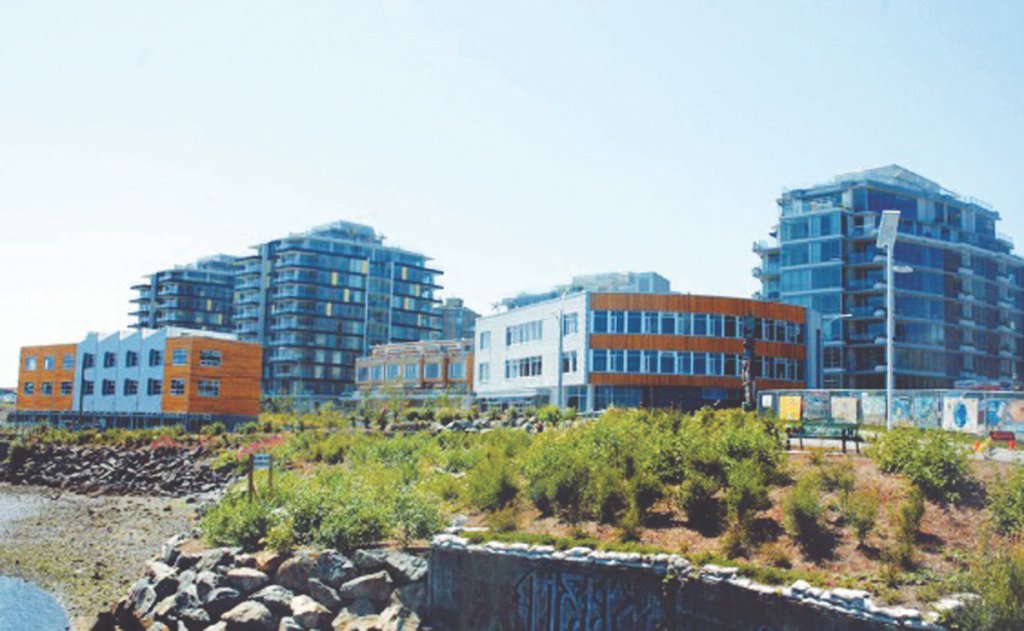By Gagandeep Ghuman
Published: Oct 18, 2014
It was a visionary plan to create alternative energy, reduce greenhouse gas emissions, and improve the district’s fiscal performance. But eight years after it was first proposed, the Neighbourhood Energy Utility plan remains on paper languishes somewhere in the district’s reports.
Common in Europe, the idea behind NEU is to create a sustainable energy cycle: Low-carbon, non-renewable energy such as sewage and wood waste is used to provide heat and hot water in high-density neighbourhood.
The goal is to reduce carbon emissions, but also to keep energy local and affordable. It often involves central production of heat rather than installing separate heating system in each development.
In 2009, district planner Sabina Foofat first suggested the district take the lead on a NEU for Waterfront Landing and the Oceanfront development. Five years later, there has been nothing but inaction on it.
While the Waterfront Landing project is still in limbo, a NEU could have been established for Oceanfront, Kingswood or Crumpit Wood neighbourhood.
District of Squamish first did a feasibility study to create a similar Neighbourhood Energy Utility (NEU) in 2010.
The feasibility study was done for Waterfront Landing with an aim to replicate the model on developments including the Squamish Oceanfront.
City planner Sabina Foofat told the council at the time bio-mass energy, ocean heat and cogeneration were the most viable district-scale energy options for downtown Squamish.
While the district has put its NEU plans on a backburner, NEUs are successfully providing sustainable energy to customers in Vancouver and Victoria.
The False Creek plant in Vancouver, for example, uses waste thermal energy from sewage to provide heating to the neighborhood.
According to the City of Vancouver, it captures more than 60 per cent of the global warming pollution associated with heated buildings. A 2010 report by the city engineers noted customers are being charges less than what they would pay BC Hydro.
It’s a similar story at North Vancouver, where Lonsdale Energy Corporation circulates hot water through a network of underground pipes and mini-plants to heat the buildings.
Lonsdale Energy Corp. uses natural gas boilers to produce its heat, but solar panels and heat recovery from space-cooling heat pumps is also used in priority when available.
In Victoria, a residential development, Dockside Community utility used bio gas fuel to provide heat and hot water to its 2,500 residents. That community utility is expected to reduce 3,460 of greenhouse gas emissions, an equivalent of taking 850 cars off the road.
Ben Themens, the director of Lonsdale Energy Corp., said the purpose of the utility isn’t to provide ‘extraordinary revenue’ to the local government.
The main purpose of the municipality and LEC is not to make high profits but to improve the environment, he said.
In fact, district energy system is a very capital intensive process during its early years.
“We are paying interest to the city on a loan and we started to make a small profit after approximately 5 years of operation,” he said.
In 2009, Foofat told the council creating a NEU is a long-term business, not a one-off engineering project. Infrastructure is added over many years as the utility expands from one development to another.
It remains to be seen if the district will dust off the plan now as the Oceanfront project moves forward.





MattB says
Why doesn’t Squamish become a Canadian Solar City, like North Vancouver and Dawson Creek? Have spoken to Bob Haugen of Solar Cities Canada about this and it is certainly worth looking into. What a great issue to discuss with the upcoming election!
http://solarcitiescanada.com/uncategorized/city-of-north-vancouver-named-canadian-solar-city/
M L Stathers says
because it seems they all have bought into the great Federal & Provincial push for the very shakey LNG alleged solution for everything – energy, debt-demolishing revenue, you name it.
larry mclennan says
I suggest that you read the narrative of the site referred to by MattB. The vast majority of the energy come from-wait for it- natural gas!
Glenne Campbell says
Perhaps the new four year term will encourage council to demand five, ten, and fifteen year plans be produced. Squamish has run on single issue plans for too long.
tj says
If the ‘Enviros’ can’t even organize this, then they sure as heck have no hope with LNG…. har har
Chris tamburri says
What we really need is solar highways…. watch this
http://sfglo.be/nA
Tracy McRae says
Biomass is an overlooked but viable, cost effective solution as an energy source here in BC. Wouldn’t it be great if our municipality could be a leader in this area, initiating new job stimulation from manufacturing, maintenance, servicing & retail purchase power.
http://www.davidsuzuki.org/issues/climate-change/science/energy/biomass/
Tjay says
After you…
Lead on…